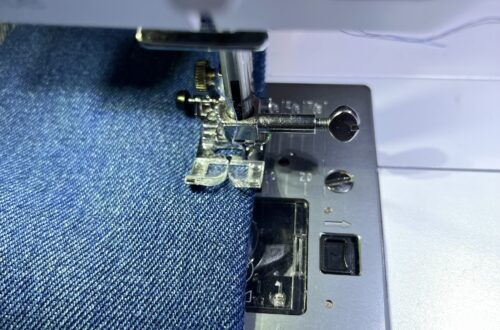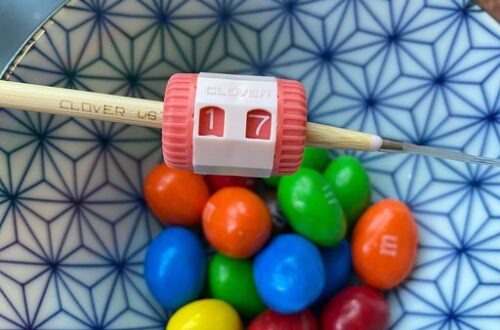Summer Embroidery Hoop Art
Summertime for me is a very busy time and somedays I never even make it upstairs to my sewing studio.
However, hand sewing projects are the best! I love having a project I can do here and there when I need a little sit down time! Embroidery fits that description perfectly!



I gravitate to happy, cheerful colors when I’m choosing a project and I’ve created a super fun and easy summer embroidery project for you. Lets get started!

Necessary Supplies:
- Pattern printed onto 8.5 x 11 inch paper
- Light colored fabric cut to 14 inches square (I used a piece of scrap vintage muslin fabric)
- Clover Water Erasable Markers (Thick) – Art. No 516
- DMC embroidery threads of your color choice
- Clover Embroidery Needles (see *note below) – Art. No 235
- Clover Embroidery Hoop (7″) – Art. No 8812
- 8 different 1 inch square fabric scraps
- 5 inch square of Clover Wonder Fuse – Art. No 4090
- 11 inch wooden embroidery hoop (used to frame your finished project)
- Hot glue gun
- 14 inch square of white felt
- Optional: 30 inches ribbon, fabric scrap, or other decorative trim

*NOTE: Before we get started on the instructions, here is a side note on the Clover Embroidery Needles. I sampled a lot of different needles for this project and the ones I recommend the most are the Gold Eye Embroidery Needles No. 3-9. This packet gives you multiple sizes to choose from. I used several sizes in this project, depending on how many strands of thread I used.
Instructions:

Step 1: Download the pattern and print onto 8.5 x 11 inch paper.

You will now trace your pattern onto the square fabric piece. There are many ways to do this but my favorite is very simple. Tape the printed pattern to a window. Now tape your fabric over the pattern and using the Water Erasable Marker carefully trace the pattern onto your fabric. This is best done in the bright light of day when the sun shining through the pattern makes it easier to see the lines. Don’t get too concerned if your lines aren’t perfect! This pattern leaves a lot of room for error!

Step 2: Place your fabric in the Clover Embroidery Hoop and get started stitching! I’ve purposely made this pattern very simple and mostly used the back stitch, stem stitch and french knots. You can make it as simple as you’d like or as complicated by adding intricate stitches. (If you have never embroidered before I would recommend watching some YouTube videos of basic embroidery stitches. There are so many amazing tutorials to help you learn to embroider.)

A few stitches I used (see close up picture above):
- Back Stitch and Stem Stitch for the house outlines (six strands of thread)
- French Knots to decorate the roof on one of the houses and for the door knobs (four strands of thread)
- Straight Stitch on the grass (six strands of thread)
- Back Stitch on the smoke from the chimney (two strands of thread)
- Staggered Back Stitches to fill in the chimney (six strands of thread)
- Back Stitch on the bunting (four strands of thread)
- Lazy Daisy Stitch on the two little flowers (two strands of thread)
Step 3: Continue stitching all of the pattern except for the bunting along the top. Remove your fabric from the embroidery hoop.

Step 4: Now we will make the bunting. You will need your little fabric scraps, Clover Wonder Fuse and an iron for this step. (I like to use the Cover Mini Iron but you can use a regular size iron too.)

Make yourself a little pattern out of paper the size of the drawn bunting triangle and cut eight triangles from different fabric scraps. You will also cut eight tiny little rectangles of Wonder Fuse.

Step 5: Using an iron, adhere each little rectangle of Wonder Fuse to the back of each fabric triangle. (These little pieces of Wonder Fuse serve to adhere the bunting to the fabric to make it easier to hand sew them into place. They are not meant to be the size of the bunting. )

Step 6: Remove the paper backing, leaving the invisible fusing attached. Now you will lay each fabric triangle to your embroidered fabric, laying it on the marked lines. Once you have them laid out the way you like, carefully iron them to the fabric, this will lightly fuse them so that stitching is easier.

Step 7: Place your fabric into the embroidery hoop again. Using a simple embroidery back-stitch follow the marked line to attach your bunting. (I added the little bow at the top where the bunting comes together, but that is optional.)

Step 8: When your bunting is complete, you are ready to remove your fabric from the hoop. You will need to remove the pen marks at this time and it is a very simple process of spraying your entire fabric with water. Let it sit until it dries and all the blue marks should be gone. If not, you can just give it another spray. Once it is completely dry, carefully iron your fabric until all the wrinkles are gone. I used a little bit of spray starch for this step. Set aside.

Step 9: You can choose to decorate your wooden hoop, or you can leave it plain. I’ve done it both ways but for this project I chose to wrap it with a long fabric strip. There are so many tutorials online to help you with this process. My favorite tutorial is here. However, I will say that I love the look for a raw wood hoop just as much as a fabric covered one! So leaving out this step will still result in a beautiful piece of hoop art!

Step 10: Now you will place your ironed embroidery piece into the wooden hoop. Place it on the smaller backing hoop and then carefully center your top hoop, pushing it down over the fabric and onto the smaller hoop. Tighten the screw and then very gently pull the fabric so that all the wrinkles and creases are stretched out. The goal is to have it fit in the hoop very tightly but not stretched.

Step 11: Trim the excess fabric so there is about 1/4 inch overhang. It’s important to use good sharp scissors for this so that you’re not fighting with cutting a nice straight overhang of fabric.

Step 12: Using a hot glue gun, place a small bead of glue on the inside of the hoop, being careful not to get any on the back of your embroidery fabric. I worked in very small one inch segments. While your glue is hot, fold the overhang fabric to the inside of the hoop adhering to the hot glue. Continue all the way around your hoop until all of the fabric is nicely secured to the inside of the hoop.

Step 13: Take your felt square and place your hoop on top. Trace around the hoop onto the felt forming a circle. Cut along the inside of the traced line. Using your hot glue gun, glue your felt onto the back of the hoop, small segments at a time until you have it firmly glued in place. This step is optional, but I do like the finished look that it gives.
 Step 14: Tie a piece of ribbon or trim to your hoop art to make it easier to hang.
Step 14: Tie a piece of ribbon or trim to your hoop art to make it easier to hang.

Your beautiful summer hoop art project is complete and ready to enjoy! I hope this project brought some a little bit of happy to you today!
~ Dori ~
Find Dori on her Blog | Instagram | Pinterest
Stay connected with Clover on Facebook | Twitter | Instagram | Pinterest | YouTube | Ravelry


